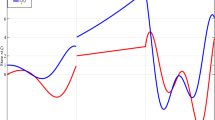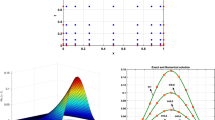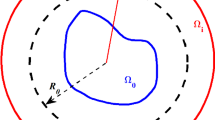Abstract
Fractional differential equations provide a tractable mathematical framework to describe anomalous behavior in complex physical systems, yet they introduce new sensitive model parameters, i.e. derivative orders, in addition to model coefficients. We formulate a sensitivity analysis of fractional models by developing a fractional sensitivity equation method. We obtain the adjoint fractional sensitivity equations, in which we present a fractional operator associated with logarithmic-power law kernel. We further construct a gradient-based optimization algorithm to compute an accurate parameter estimation in fractional model construction. We develop a fast, stable, and convergent Petrov–Galerkin spectral method to numerically solve the coupled system of original fractional model and its corresponding adjoint fractional sensitivity equations.









Similar content being viewed by others

References
West, B.J., Bologna, M., Grigolini, P.: Physics of Fractal Operators. Springer, New York (2003)
West, B.J.: Fractional Calculus View of Complexity: Tomorrows Science. CRC Press, Boca Raton (2016)
Mainardi, F.: Fractional Calculus and Waves in Linear Viscoelasticity: An Introduction to Mathematical Models. Imperial College Press, London (2010)
Suzuki, J.L., Zayernouri, M., Bittencourt, M.L., Karniadakis, G.E.: Fractional-order uniaxial visco-elasto-plastic models for structural analysis. Comput. Methods Appl. Mech. Eng. 308, 443 (2016)
Meral, F.C., Royston, T.J., Magin, R.: Fractional calculus in viscoelasticity: an experimental study. Commun. Nonlinear Sci. Numer. Simul. 15(4), 939 (2010)
Baeumer, B., Benson, D.A., Meerschaert, M., Wheatcraft, S.W.: Subordinated advection-dispersion equation for contaminant transport. Water Resour. Res. 37(6), 1543 (2001)
Jaishankar, A., McKinley, G.H.: A fractional K-BKZ constitutive formulation for describing the nonlinear rheology of multiscale complex fluids. J. Rheol. (1978-present) 58(6), 1751 (2014)
Sreenivasan, K.R., Antonia, R.A.: The phenomenology of small-scale turbulence. Ann. Rev. Fluid Mech. 29(1), 435 (1997)
Jha, R., Kaw, P.K., Kulkarni, D.R., Parikh, J.C., Team, A.: Evidence of Lévy stable process in tokamak edge turbulence. Phys. Plasmas (1994-present) 10(3), 699 (2003)
del Castillo-Negrete, D., Carreras, B.A., Lynch, V.E.: Fractional diffusion in plasma turbulence. Phys. Plasmas (1994-present) 11(8), 3854 (2004)
Jaishankar, A., McKinley, G.H.: Power-law rheology in the bulk and at the interface: quasi-properties and fractional constitutive equations. Proc. R. Soc. A Math. Phys. Eng. Sci. 469(2149), 20120284 (2013)
Naghibolhosseini, M.: Estimation of outer-middle ear transmission using DPOAEs and fractional-order modeling of human middle ear. In: Ph.D. Thesis, City University of New York, NY (2015)
Naghibolhosseini, M., Long, G.R.: Fractional-order modelling and simulation of human ear. Int. J. Comput. Math. 95(6–7), 1257 (2018)
Magin, R.L.: Fractional calculus models of complex dynamics in biological tissues. Comput. Math. Appl. 59(5), 1586 (2010)
Anastasio, T.J.: The fractional-order dynamics of brainstem vestibulo-oculomotor neurons. Biol. Cybern. 72(1), 69 (1994)
Djordjević, V.D., Jarić, J., Fabry, B., Fredberg, J.J., Stamenović, D.: Fractional derivatives embody essential features of cell rheological behavior. Ann. Biomed. Eng. 31(6), 692 (2003)
Le Méhauté, A.: Fractal Geometries Theory and Applications. CRC Press, Boca Raton (1991)
Duarte, F.B., Machado, J.T.: Chaotic phenomena and fractional-order dynamics in the trajectory control of redundant manipulators. Nonlinear Dyn. 29(1), 315 (2002)
Martins, J., Kroo, I., Alonso, J.: In: Proceedings of the 38th Aerospace Sciences Meeting (Reno, NV, 2000), AIAA, pp. 2000–0689
Sobieski, J.S.: Sensitivity of complex, internally coupled systems. AIAA J. 28, 153–160 (1990)
Liu, S., Canfield, R.A.: Two forms of continuum shape sensitivity method for fluid-structure interaction problems. J. Fluids Struct. 62, 46 (2016)
Zayernouri, M., Metzger, M.: Coherent features in the sensitivity field of a planar mixing layer. Phys. Fluids (1994-present) 23(2), 025105 (2011)
Stanford, B., Beran, P., Kurdi, M.: Adjoint sensitivities of time-periodic nonlinear structural dynamics via model reduction. Comput. Struct. 88(19), 1110 (2010)
Bischof, C., Khademi, P., Mauer-Oats, A., Carle, A.: Adifor 2.0: automatic differentiation of Fortran 77 program. In: IEEE Computational Science and Engineering (1996)
Bischof, C., Roh, L., Mauer-Oats, A.: ADIC: an extensible automatic differentiation tool for ANSI-C. Softw. Pract. Exp. 27, 1427–1456 (1997)
Bischof, C., Land, B., Vehreschild, A.: Proceeding in Applied Mathematics and Mechanics, vol. 2, pp. 50–53 (2003)
Van Keulen, F., Haftka, R.T., Kim, N.H.: Review of options for structural design sensitivity analysis, part 1: linear systems. Comput. Methods Appl. Mech. Eng. 194(30), 3213 (2005)
Wei, H., Chen, W., Sun, H., Li, X.: A coupled method for inverse source problem of spatial fractional anomalous diffusion equations. Inverse Problems Sci. Eng.: Former. Inverse Problems Eng. 18(7), 945 (2010)
Chakraborty, P., Meerschaert, M.M., Lim, C.Y.: Parameter estimation for fractional transport: A particle-tracking approach. Water Resour. Res. 45, W10415 (2009). https://doi.org/10.1029/2008WR007577
Cho, Y., Kim, I., Sheen, D.: A fractional-order model for minmod millennium. Math. Biosci. 262, 36 (2015)
Kelly, J.F., Bolster, D., Meerschaert, M.M., Drummond, J.D., Packman, A.I.: Fracfit: a robust parameter estimation tool for fractional calculus models. Water Resour. Res. 53(3), 2559 (2017)
Lim, C.Y., Meerschaert, M.M., Scheffler, H.P.: Parameter estimation for operator scaling random fields. J. Multivar. Anal. 123, 172 (2014)
Ghazizadeh, H.R., Azimi, A., Maerefat, M.: An inverse problem to estimate relaxation parameter and order of fractionality in fractional single-phase-lag heat equation. Int. J. Heat Mass Transf. 55(7), 2095 (2012)
Chen, S., Liu, F., Jiang, X., Turner, I., Burrage, K.: Fast finite difference approximation for identifying parameters in a two-dimensional space-fractional nonlocal model with variable diffusivity coefficients. SIAM J. Numer. Anal. 54(2), 606 (2016)
Yu, B., Jiang, X.: Numerical identification of the fractional derivatives in the two-dimensional fractional cable equation. J. Sci. Comput. 68(1), 252 (2016)
Yu, B., Jiang, X., Qi, H.: Numerical method for the estimation of the fractional parameters in the fractional mobile/immobile advection-diffusion model. Int. J. Comput. Math. 95, 1–20 (2017)
Gorenflo, R., Mainardi, F., Moretti, D., Paradisi, P.: Time fractional diffusion: a discrete random walk approach. Nonlinear Dyn. 29(1–4), 129 (2002)
Sun, Z., Wu, X.: A fully discrete difference scheme for a diffusion-wave system. Appl. Numer. Math. 56(2), 193 (2006)
Lin, Y., Xu, C.: Finite difference/spectral approximations for the time-fractional diffusion equation. J. Comput. Phys. 225(2), 1533 (2007)
Wang, H., Wang, K., Sircar, T.: A direct \(o (n log^2 n)\) finite difference method for fractional diffusion equations. J. Comput. Phys. 229(21), 8095 (2010)
Wang, K., Wang, H.: A fast characteristic finite difference method for fractional advection-diffusion equations. Adv. Water Resour. 34(7), 810 (2011)
Cao, J., Xu, C.: A high order schema for the numerical solution of the fractional ordinary differential equations. J. Comput. Phys. 238(1), 154 (2013)
Zeng, F., Li, C., Liu, F., Turner, I.: Numerical algorithms for time-fractional subdiffusion equation with second-order accuracy. SIAM J. Sci. Comput. 37(1), A55 (2015)
Zayernouri, M., Matzavinos, A.: Fractional Adams-Bashforth/Moulton methods: an application to the fractional Keller–Segel chemotaxis system. J. Comput. Phys. 317, 1–14 (2016)
Rawashdeh, E.: Numerical solution of fractional integro-differential equations by collocation method. Appl. Math. Comput. 176(1), 1 (2006)
Khader, M.: On the numerical solutions for the fractional diffusion equation. Commun. Nonlinear Sci. Numer. Simul. 16(6), 2535 (2011)
Khader, M., Hendy, A.: The approximate and exact solutions of the fractional-order delay differential equations using legendre pseudospectral method. Int. J. Pure Appl. Math. 74(3), 287 (2012)
Li, X., Xu, C.: A space-time spectral method for the time fractional diffusion equation. SIAM J. Numer. Anal. 47(3), 2108 (2009)
Li, X., Xu, C.: Existence and uniqueness of the weak solution of the space-time fractional diffusion equation and a spectral method approximation. Commun. Comput. Phys. 8(5), 1016 (2010)
Chen, S., Shen, J., Wang, L.: Generalized Jacobi functions and their applications to fractional differential equations. arXiv:1407.8303 (2014)
Wang, H., Zhang, X.: A high-accuracy preserving spectralGalerkin method for the Dirichlet boundary-value problem of variable-coefficient conservative fractional diffusion equations. J. Comput. Phys. 281, 67 (2015)
Bhrawy, A.H., Doha, E.H., Baleanu, D., Ezz-Eldien, S.S.: A spectral tau algorithm based on Jacobi operational matrix for numerical solution of time fractional diffusion-wave equations. J. Comput. Phys. 293, 142 (2015)
Zayernouri, M., Karniadakis, G.E.: Fractional Sturm–Liouville eigen-problems: theory and numerical approximations. J. Comput. Phys. 47–3, 2108 (2013)
Zayernouri, M., Ainsworth, M., Karniadakis, G.E.: Tempered fractional Sturm–Liouville eigenproblems. SIAM J. Sci. Comput. 37(4), A1777 (2015)
Samiee, M., Zayernouri, M., Meerschaert, M.M.: A unified spectral method for FPDEs with two-sided derivatives; part I: a fast solver. J. Comput. Phys. (2018). https://doi.org/10.1016/j.jcp.2018.02.014
Samiee, M., Kharazmi, E., Zayernouri, M.: Spectral and High Order Methods for Partial Differential Equations ICOSAHOM 2016. Springer, New York, pp. 651–667
Kharazmi, E., Zayernouri, M., Karniadakis, G.E.: Petrov–Galerkin and spectral collocation methods for distributed order differential equations. SIAM J. Sci. Comput. 39(3), A1003 (2017)
Kharazmi, E., Zayernouri, M., Karniadakis, G.E.: A Petrov–Galerkin spectral element method for fractional elliptic problems. Comput. Methods Appl. Mech. Eng. 324, 512–536 (2017)
Kharazmi, E., Zayernouri, M.: Fractional pseudo-spectral methods for distributed-order fractional PDES. Int. J. Comput. Math. 95(6–7), 1340–1361 (2018)
Lischke, A., Zayernouri, M., Karniadakis, G.E.: A Petrov–Galerkin spectral method of linear complexity for fractional multiterm ODEs on the half line. SIAM J. Sci. Comput. 39(3), A922 (2017)
Samiee, M., Zayernouri, M., Meerschaert, M.M.: A unified spectral method for FPDEs with two-sided derivatives; part II: Stability, and error analysis. J. Comput. Phys. (2018). https://doi.org/10.1016/j.jcp.2018.07.041
Miller, K.S., Ross, B.: An Introduction to the Fractional Calculus and Fractional Differential Equations. Wiley, New York (1993)
Podlubny, I.: Fractional Differential Equations. Academic Press, San Diego (1999)
Ervin, V.J., Roop, J.P.: Variational solution of fractional advection dispersion equations on bounded domains in \(\text{ R }^d\). Numer. Methods Partial Differ. Equ. 23(2), 256 (2007)
Atanackovic, T.M., Pilipovic, S., Stankovic, B., Zorica, D.: Fractional Calculus with Applications in Mechanics: Vibrations and Diffusion Processes. Wiley, New York (2014)
Afzali, F., Kapucu, O., Feeny, B.F.: In: ASME 2016 International Design Engineering Technical Conferences and Computers and Information in Engineering Conference. American Society of Mechanical Engineers (2016)
Afzali, F., Acar, G.D., Feeny, B.F.: In: ASME 2017 International Design Engineering Technical Conferences and Computers and Information in Engineering Conference (American Society of Mechanical Engineers, 2017), pp. V008T12A050–V008T12A050
Zamani, V., Kharazmi, E., Mukherjee, R.: Asymmetric post-flutter oscillations of a cantilever due to a dynamic follower force. J. Sound Vib. 340, 253 (2015)
Author information
Authors and Affiliations
Corresponding author
Additional information
Publisher's Note
Springer Nature remains neutral with regard to jurisdictional claims in published maps and institutional affiliations.
This work was supported by the AFOSR Young Investigator Program (YIP) Award (FA9550-17-1-0150).
Appendices
Proof of Lemma 1
Part A: \(\sigma \in (0,1)\). We start from the \(RL-PL\) definition, given in (8).
Part B: \(\sigma \in (1,2)\). Similarly, we start from the \(RL-PL\) definition, given in (8).
Proof of Lemma 2
In Lemma 2.1 in [49] and also in [64], it is shown that \(\Vert \cdot \Vert _{{^l}H^{\sigma }_{}({\varLambda })}\) and \(\Vert \cdot \Vert _{{^r}H^{\sigma }_{}({\varLambda })}\) are equivalent. Therefore, for \(u \in H^{\sigma }_{}({\varLambda })\), there exist positive constants \(C_1\) and \(C_2\) such that
which leads to
where \(\tilde{C}_1\) is a positive constant. Similarly, we can show that \(\Vert u \Vert _{{^c}H^{\sigma }_{}({\varLambda })}^2 \le \tilde{C}_2 \, \Vert u \Vert _{{}H^{\sigma }_{}({\varLambda })}\), where \(\tilde{C}_2\) is a positive constant.
Proof of Lemma 4
\(\mathcal {X}_1\) is endowed with the norm \(\Vert \cdot \Vert _{\mathcal {X}_1}\), where \(\Vert \cdot \Vert _{\mathcal {X}_1}\equiv \Vert \cdot \Vert _{{^c}H^{\beta _1/2}_{}({\varLambda }_1)}\) by Lemma 2. Moreover, \(\mathcal {X}_2\) is associated with the norm
where
and
We use the mathematical induction to carry out the proof. Therefore, we assume the following equality holds
Since,
and
we can show that
Proof of Lemma 7
According to [57], we have \({}_{a_i}^{}{\mathcal {D}}_{x_i}^{\beta _i} u={}_{a_i}^{}{\mathcal {D}}_{x_i}^{\beta _i/2} ({}_{a_i}^{}{\mathcal {D}}_{x_i}^{\beta _i/2} u)\) and \({}_{x_i}^{}{\mathcal {D}}_{b_i}^{\beta _i/2} u={}_{x_i}^{}{\mathcal {D}}_{b_i}^{\beta _i/2}({}_{x_i}^{}{\mathcal {D}}_{b_i}^{\beta _i/2} u)\). Let \(\bar{u}={}_{a_i}^{}{\mathcal {D}}_{x_i}^{\beta _i/2} u\). Then,
Based on the homogeneous boundary conditions, \(\left\{ \frac{v}{{\varGamma }(1-\beta _i/2)\int _{a_i}^{x_i} \frac{\bar{u}ds}{(x_i-s)^{\beta _i/2}}} \right\} ^{b_i}_{x_i=a_i}=0.\) Therefore,
Moreover, we find that
Therefore, we get
Proof of Lemma 8
We know that
Therefore, by Hölder inequality
Moreover, by equivalence of \(\vert \cdot \vert _{H^{s}(I)} \equiv \vert \cdot \vert ^{*}_{H^{s}(I)} = \vert \cdot \vert ^{1/2}_{{^l}H^{s}(I)} \vert \cdot \vert ^{1/2}_{{^r}H^{s}(I)} \) we have
where \(0<\tilde{\beta }_1\le 1\). Therefore,
where \(0<\tilde{\beta }_2\le 1\) and \(0<\bar{\beta }\).
Proof of the Stability Theorem 5
Part A: \(d=1\). It is evident that u and v are in Hilbert spaces (see [49, 64]). For \(0< \tilde{\beta } \le 1\), we have
since \({\sup }_{{u \in U}} \vert a(u , v)\vert >0\). Next, by equivalence of spaces and their associated norms, (63), and (64), we obtain
and
where \(C_1\), \(C_2\), and \(C_3\) are positive constants. Therefore,
where \(\tilde{C}\) is \(min\{C_1, \, C_2, \, C_3 \}\). Also, the norm \( \Vert u \Vert _{U} \, \Vert v \Vert _{V}\) is equivalent to the right hand side of inequality (93). Therefore, \(\vert a(u,v)\vert \ge C \, \Vert u \Vert _{U}\Vert v \Vert _{V}\).
Part B: \(d > 1\). Similarly, we have
where \(0< \beta \le 1\). Recalling that as the direct consequences of (63), we obtain
Thus,
for \(u,\, v \in L^2(I; \mathcal {X}_d)\), where \(0<\tilde{C}\) and \(0<\tilde{\beta }\le 1\). Furthermore, Lemma 8 yields
Therefore, from (95) and (96) we have
where
for \(u \in U \), \(v \in U\) and \(0<\tilde{C}_2\le 1\). By considering (97) and (98), we get
Rights and permissions
About this article
Cite this article
Kharazmi, E., Zayernouri, M. Fractional Sensitivity Equation Method: Application to Fractional Model Construction. J Sci Comput 80, 110–140 (2019). https://doi.org/10.1007/s10915-019-00935-0
Received:
Revised:
Accepted:
Published:
Issue Date:
DOI: https://doi.org/10.1007/s10915-019-00935-0



